Briggo's robot-run Coffee Haus: The future of coffee is not half-bad
Chalk up another win for the machines

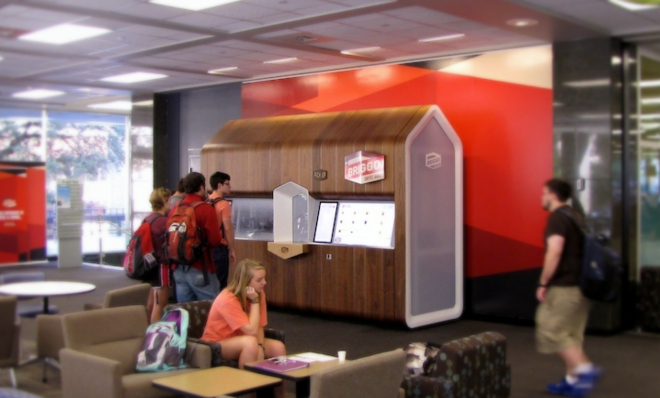
Over the summer, an Austin start-up called Briggo installed a coffee machine on the University of Texas campus. But calling it a "coffee machine" really undersells the technological marvel that is Briggo's inaugural Coffee Haus kiosk — the van-sized contraption houses a robot built to replicate the skills of a master barista.
In this case, a preternaturally precise and consistent barista with a micro-level awareness of everything from the temperature of the milk to the exact fineness of the the grind. The perfect barista. As long as you don't want it to carry on a conversation.
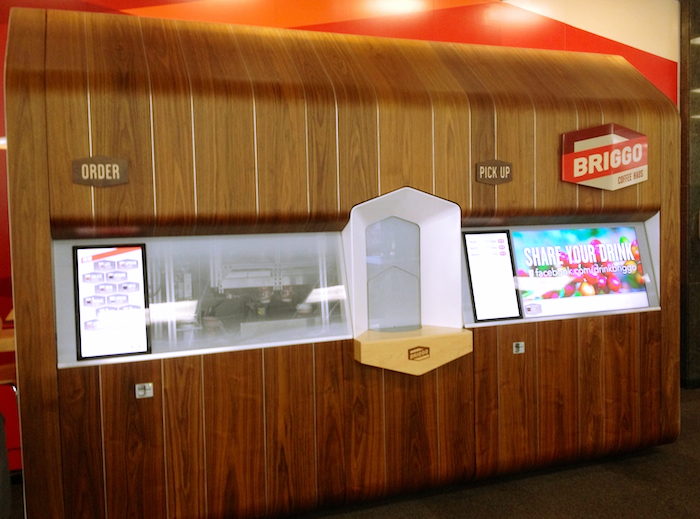
The company is the brainchild of founder Charles Studor, and was named in honor of his grandfather, who owned the Briggs Machine Tool Co. of Syracuse, N.Y. It's not just an Italianized version of Briggs, either — the "go" stands for movement, portability, and (presumably) caffeine.
The Week
Escape your echo chamber. Get the facts behind the news, plus analysis from multiple perspectives.

Sign up for The Week's Free Newsletters
From our morning news briefing to a weekly Good News Newsletter, get the best of The Week delivered directly to your inbox.
From our morning news briefing to a weekly Good News Newsletter, get the best of The Week delivered directly to your inbox.
Studor, who is also chief technology officer, comes to coffee from a long career in semiconductors. There are some Starbucks alumni handling the coffee bean end.
Quartz's Christopher Mims does a fine job running through the business and technical aspects of Briggo. And Slate's Will Oremus explains why robot baristas probably won't replace your favorite coffee slinger at Starbucks (short answer: Customer service). But the recent spate of news reports miss one big thing: Nobody tried the coffee.
I live in Austin, the only place in the world with a Briggo Coffee Haus. (A second one is planned for the Austin airport.) I went to pay a visit last week. Here's what it's like to order coffee from a robot barista.
First of all, it's fun. There are no cute names or drink sizes, just numbers and ingredients. The robot barista won't judge you if you ask for "tall" instead of "medium." But of course, you don't actually say anything. You touch a screen — either the large one on the front of the Coffee Haus or, if you plan ahead, your smartphone.
A free daily email with the biggest news stories of the day – and the best features from TheWeek.com
The process is pretty simple, at least on the customer end: Order, wait, pick up your drink from a revolving door that turns with a satisfyingly futuristic whirr:
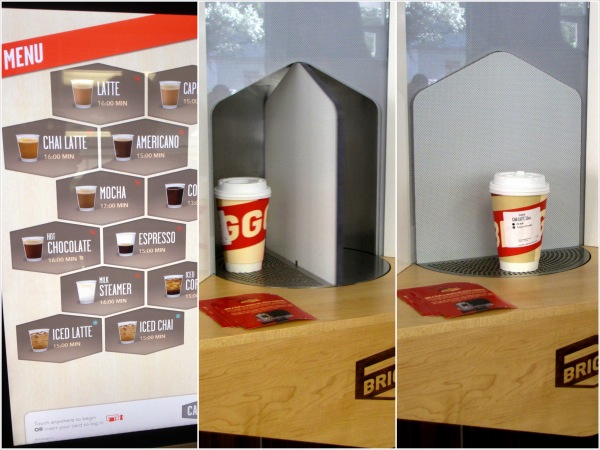
I ordered a cappuccino, the hardest espresso drink to make correctly, and an Americano, the easiest. You can customize your order a number of ways. The espresso shots come in pairs. There are a few kinds of milk, including soy (I got 0.5 ounces of 2 percent in the Americano). There are several syrups to choose from: Chocolate, vanilla, and caramel. And there are three sizes.
Along with the usual espresso drinks are drip coffee, chai tea lattes, steamed milk, hot chocolate, and iced versions of the popular drinks (this is Texas; that's a must). There is no decaf, at least not yet.
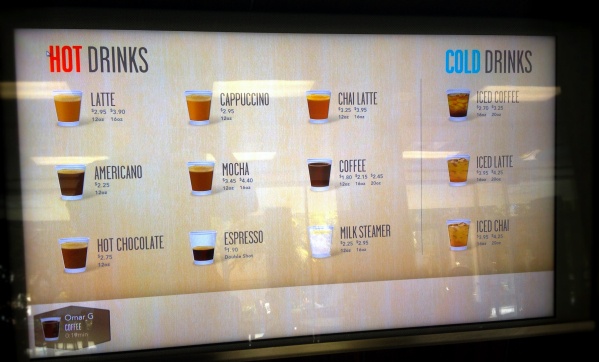
When you order, it estimates how long you'll wait for your coffee. My drinks took about 14 minutes to prepare, but the idea behind the smartphone app is that you can order from class, or en route to the Briggo station. You can see where your drink is in a virtual queue, with your name (from your credit card or whatever name you choose if you open up a Briggo account) and time remaining.
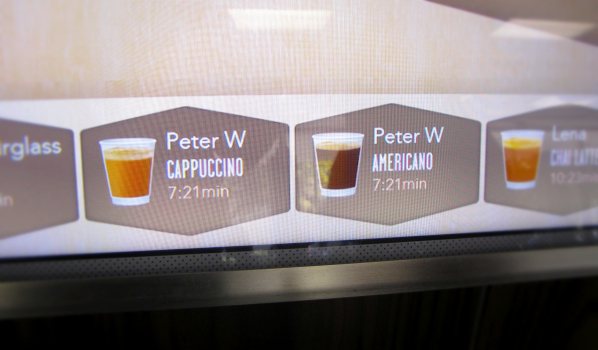
So nobody picks up your drink by accident (or evil intent), the machine sends a three-digit code to your smartphone. When it's ready, you have about 15 minutes to pick it up before it "expires." (If you miss the deadline, the drink will eventually be thrown out; since you've already paid for the drink, the incentives are all yours not to flake out.)
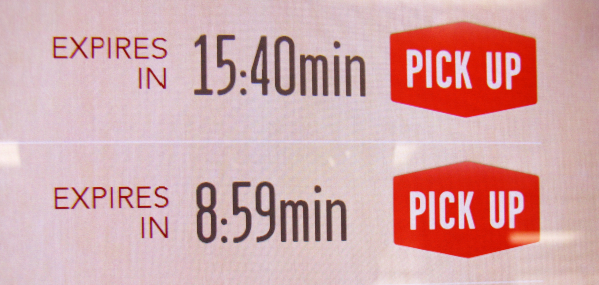
After about a quarter of an hour, the moment of truth arrived. My name came up on the pick-up screen, I typed in my three-digit code, and the door started turning — twice, once for each drink. If you're really into latte-foam art, the Briggo Coffee Haus isn't for you. But the machine barista's cappuccino was surprisingly good:
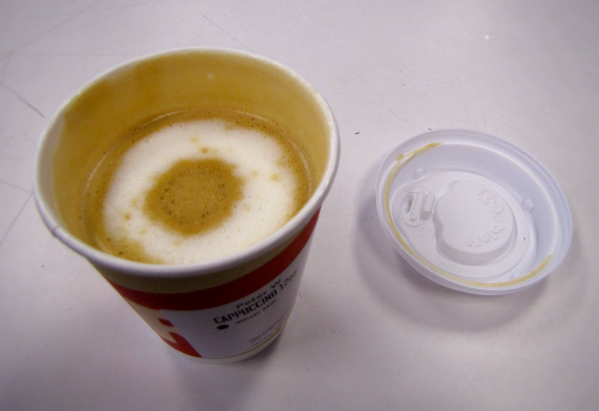
It wasn't the best cappuccino I've ever had, not even in the top 10. The perfect cappuccino isn't, as Starbucks will tell you, half foam and half steamed milk — the milk has to be freshly steamed, with the froth and liquid indistinguishable. Briggo's drink was closer to what I think of as a latte, a hot milk and espresso mix topped with a small cap of foam.
But it was clearly the best coffee I've ever had from an automated machine. And that's no small feat. The drinks, especially the Americano but also the cappuccino, were better than what I've had at many coffee shops. The prices are competitive with Starbucks and other high-end chains — they are aiming for that level of quality, so there's no machine discount.
The beans are well-roasted — not under-roasted like at some of the newer coffee meccas, but not burnt either. Briggo is aiming for balance, and it achieves that. The company currently use a blend of beans from Guatemala, Costa Rica, Colombia, and Papua New Guinea, but that could change.
Briggo's Coffee Haus is ready for prime time. I agree with Slate's Oremus that it won't replace your local coffee purveyor, or even really dent the green, 500-pound gorilla in the coffee business. But as Starbucks has shown, there is a big and growing market for good coffee, and Briggo makes good coffee. Some people will prefer being served by people they can talk to (and yell at, if necessary), while others will like interacting with their smartphones.
That said, it's not really true that getting your coffee from the Briggo is a solitary experience. At least at the prototype machine, the robot barista is kept company and overseen by a host who stays nearby during the hours of operation. When I made my expedition, the hostess was Robin, a friendly UT alumna.
So if you want a human face with your coffee, you'll be relieved to discover that Briggo hasn't created an android host — yet.
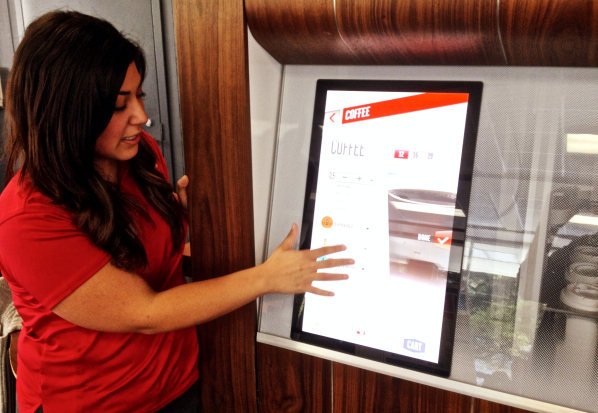
Peter has worked as a news and culture writer and editor at The Week since the site's launch in 2008. He covers politics, world affairs, religion and cultural currents. His journalism career began as a copy editor at a financial newswire and has included editorial positions at The New York Times Magazine, Facts on File, and Oregon State University.



